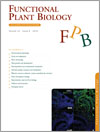
Functional Plant Biology
Volume 43 Number 9 2016
This review examines how leaf trichomes influence leaf physiological responses to environmental drivers. Analysis of work published over the last 40 years shows that reflective trichomes are protective, and that some trichomes may be important in modulating leaf water relations. Together, these findings show that trichomes can exert substantial influence over leaf energy, carbon and water balance.
FP16037Root morphological traits that determine phosphorus-acquisition efficiency and critical external phosphorus requirement in pasture species
Soils low in plant-available phosphorus are a major constraint to global agricultural production. This work investigated how root morphology influences the ability of pasture legume species to explore the soil for phosphorus and yield well under low phosphorus conditions. Selecting pasture legume species with root traits that maximise soil exploration could significantly reduce phosphorus fertiliser inputs in pasture systems.
FP16017The influence of water stress on grapevine (Vitis vinifera L.) shoots in a cool, humid climate: growth, gas exchange and hydraulics
Seasonal soil moisture deficits are known to negatively affect growth and productivity of grapevines in semiarid climates; however, less is known about the effects of reduced moisture availability in cooler and wetter regions. Here, we characterise the physiological and hydraulic responses of grapevines to reduced soil water availability in a cool climate and show that these responses differ between grapevines as well as within grapevines at the level of individual shoots based on their size.
FP16064Depicting how Eucalyptus globulus survives drought: involvement of redox and DNA methylation events
The relation between oxidative stress, DNA methylation and altered cellular function is well known in human cells but still under investigated in plants. Studying how some of these mechanisms were modulated by drought and recovery in eucalypts revealed a parallel occurrence, which is probably part of the explanation of how this species overcomes stressful conditions. Our findings are ultimately intended to encourage the scientific community to identify cellular oxidative signals that control DNA methylation and to define any causal link that may condition cellular response.
FP15337Dew absorption by the leaf trichomes of Combretum leprosum in the Brazilian semiarid region
In arid and semiarid regions, dew may represent an important water source for plants. We demonstrated that dew leaf absorption aid the maintenance hydration of leaf tissues, improve carbon assimilation and may be considered an important source of water to growth and survival of plants at seasonally dry environments.
FP16018Reduced soybean photosynthetic nitrogen use efficiency associated with evolutionary genetic bottlenecks
Feeding a growing world population requires increasing the rate of genetic crop improvement, but the lack of genetic variation in modern crops is thought to restrain this objective. Previous studies have tested if soybean wild relatives are a reservoir of genetic variation, but without considering specific physiological traits. We describe a parallel reduction in molecular marker and phenotypic photosynthetic nitrogen use efficiency diversity happening after each known soybean evolutionary bottleneck.
FP16060In vivo and in vitro approaches demonstrate proline is not directly involved in the protection against superoxide, nitric oxide, nitrogen dioxide and peroxynitrite
Plants accumulate proline under diverse stresses, and it has been suggested that proline protects against oxidative stress; however, it is still unclear whether or not its protection is due to antioxidant activity. In this study we evaluated whether proline reacts with several reactive oxygen and nitrogen species and demonstrated that proline is not a scavenger of peroxynitrite, superoxide, nitric oxide and nitrogen dioxide. This implies that describing proline as a general antioxidant molecule is not correct.
FP16098Genotypic variation in photosynthetic limitation responses to K deficiency of Brassica napus is associated with potassium utilisation efficiency
Plant cultivars higher in potassium utilisation efficiency (KUtE) are likely to have better gross CO2 assimilation and yield under potassium (K) deficiency; however, the inner link between KUtE and photosynthesis remains unclear. The differences on photosynthetic limitations between two cultivars (differ in KUtE) under K deficiency were explored here. Cultivars higher in KUtE were superiority ascribing to their lower K-based thresholds for photosynthetic limitations.
FP15242The effect of elevated CO2 and virus infection on the primary metabolism of wheat
Elevated atmospheric CO2 (eCO2) associated with climate change can impact important food crops by altering the interaction between plants and insects that spread disease. This study focuses on the biochemical response of wheat to Barley yellow dwarf virus–aphid interactions under predicted eCO2 concentrations, with the results indicating that primary metabolism is altered by both. The increased sugars induced by eCO2 and the increased amino acids induced by virus infection indicate that the virus epidemiology may change in the future.



